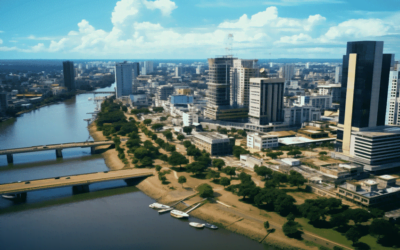Hey there, fellow drone enthusiasts and those seeking the scoop on Scotland’s drone laws. If you’re reading this, you’re likely on a mission to unravel the mysteries of these regulations. It’s understandable – I’ve been there myself, and I know how bewildering it can be.
Whether you’re a hobbyist, a budding commercial operator, or simply a curious mind, I’m here to guide you through the web of Scotland’s drone laws. So, let’s get started and put those nagging questions to rest.
Now, you might be wondering, “How do I know all this?” Well, it’s not just guesswork. I’ve delved deep into the realm of Scotland’s drone regulations, uncovering the ins and outs to provide you with answers.
From registering your drone to deciphering the different categories and understanding the significance of remote identification, I’ve done the legwork. This isn’t about dry legal jargon; it’s about sharing my experiences and insights from thorough research so that you have a reliable source of information right here.
If you’re eager to navigate Scotland’s drone laws with ease and confidence, you’re in the right place. I’ve got the answers you seek, and I’m here to make it all crystal clear for you. So, grab a cup of your favorite brew, settle in, and read on.
Whether you’re interested in recreational flying or venturing into the world of commercial drone operations, this article is your go-to source for understanding Scotland’s drone laws and ensuring a smooth and legal flight. Let’s dive into the fascinating world of drone regulations together.
The Regulatory Body

Let’s dive right into the heart of the matter – understanding the regulatory body responsible for overseeing Scotland’s drone laws. Now, you might be thinking, “Why do I need to know about this?” Well, bear with me; it’s like knowing who’s in charge of the rules of the game. In the world of drones, it’s the Civil Aviation Authority (CAA) that’s keeping things in check.
Civil Aviation Authority (CAA)
If you’re new to this or just brushing up on your knowledge, the Civil Aviation Authority (CAA) is like the guardian angel of the skies in the UK, Scotland included. They’re the ones tasked with making sure we all fly our drones safely and responsibly.
The CAA isn’t just a group of paper-pushers; they’re aviation experts, ensuring that the skies are shared harmoniously by drones, airplanes, and other airborne creatures.
Now, the CAA might sound a bit intimidating, but they’re there to help, not hinder. Think of them as your guiding star when it comes to navigating the intricacies of drone regulations. They set the rules, provide guidance, and make sure that everyone plays by the book.
CAA’s Role in Regulating Drones
So, what’s the CAA’s role in all of this? Well, when it comes to drones, they wear many hats. They’re the ones who define the categories for drones, like C0, C1, C2, and C3, based on weight.
These categories determine the specific regulations that apply to different drones. Whether you’ve got a feather-light C0 drone or a heftier C3 model, the CAA’s got you covered.
They’re also the architects of no-fly zones, the areas where drones are strictly prohibited, such as near airports and military bases. These rules exist to keep our skies safe and secure, and it’s the CAA’s job to enforce them.
Coordination with Devolved Authorities
Now, here’s where it gets interesting, especially for our Scottish friends. The CAA works hand-in-hand with devolved authorities, which means that while there are overarching UK regulations, Scotland has some say in shaping its drone laws.
This partnership ensures that the rules are not only relevant but also tailored to the unique needs and concerns of Scotland.
In a nutshell, the CAA is the wizard behind the curtain when it comes to Scotland’s drone laws. They’re not here to rain on your drone parade but to ensure that the skies remain friendly, safe, and open for all.
So, the next time you’re itching to send your drone soaring through the Scottish skies, remember to check in with your friendly neighborhood drone authority – the CAA.
Also Read: Saudi Arabia Drone Laws 2024
Categorization of Drones

Alright, let’s dive into the fascinating world of drone categorization. You might be thinking, “Why does this even matter?” Well, my friend, it matters quite a bit. Drone categories determine the rules you need to follow and the regulations you need to be aware of.
It’s like understanding the size of the playing field in a game; it’s crucial. So, let’s unravel the mystery of drone categories.
Different Drone Categories
1. C0 – Less than 250 grams: First up, we have the featherweights – drones in the C0 category, weighing less than 250 grams. These little wonders are like the hummingbirds of the drone world.
Their lightweight nature might make you think they’re a breeze to fly, but that doesn’t mean they’re exempt from the rules. Even these tiny flyers have their set of regulations to follow. So, whether you’ve got a tiny selfie drone or a palm-sized marvel, it’s important to stay in the know.
2. C1 – 250 grams to 900 grams: Now, let’s talk about the C1 category – drones that tip the scales between 250 grams and 900 grams.
These are like the middleweights in the drone world. Not too small, not too hefty, they offer a sweet spot for many drone enthusiasts. Regulations for these drones might be a bit more complex, but they’re designed to strike a balance between safety and enjoyment.
3. C2 – 900 grams to 4 kilograms: Moving up the ladder, we’ve got the C2 category, drones weighing between 900 grams and 4 kilograms.
These are the heavyweight champs, and they’re built for performance. However, as the weight increases, so do the responsibilities. Understanding the regulations for C2 drones is essential to ensure safe and responsible flying.
4. C3 – 4 kilograms to 25 kilograms: Last but not least, we have the heavyweights, the C3 category drones, weighing between 4 kilograms and 25 kilograms.
These drones are like the giants of the skies, often used for commercial and industrial purposes. With their power and size come stringent rules to guarantee safety and prevent mishaps.
Implications of Categorization
Now, you might wonder, “Why do these categories matter?” Well, it’s all about ensuring safety in the skies. Different drone categories come with distinct regulations to prevent accidents, protect privacy, and keep our aerial playground secure. The category you fall into dictates the dos and don’ts of your drone operations, and it’s crucial to understand and adhere to these rules.
Registration and Operator ID
When you’re venturing into the world of drones, registration is a topic that can’t be overlooked. Whether you’re flying a featherweight C0 or a heavyweight C3, drone operators are required to register and obtain an Operator ID.
It’s like your drone’s birth certificate, and it’s a necessary step to fly your bird legally. So, regardless of your drone’s category, registration and Operator ID are vital aspects to be aware of on your drone journey.
Also Read: Sao Tome and Principe Drone Laws 2024
General Drone Regulations

Now, let’s wade into the pool of general drone regulations. These are the rules that apply to all drone operators, regardless of the category of drone you fly. They’re like the common ground for everyone in the drone community. So, let’s get acquainted with what it takes to be a responsible drone pilot.
Registration and Operator ID Requirements
When it comes to drone flying, there’s no room for anonymity. Registration and obtaining an Operator ID is a fundamental requirement. It’s like getting your driver’s license for the sky. The process is straightforward but essential.
You provide your details, pay a nominal fee, and voila, you’re officially recognized as a drone operator. This helps authorities keep tabs on who’s flying and ensures a sense of accountability in the drone community.
Responsible and Safe Flying Practices
1. Maintaining Line-of-Sight: One of the golden rules of responsible drone flying is maintaining a clear line of sight with your bird. This means you should always keep your drone within your visual range. It’s like driving a car – you wouldn’t navigate it blindfolded. Keeping a watchful eye on your drone ensures you can react swiftly to any unexpected situations and helps prevent accidents.
2. Avoiding Crowds and People: Now, let’s talk about being a courteous pilot. Avoiding crowds and people is crucial. It’s like respecting personal space on the ground. Flying your drone directly over people or crowded areas can lead to unwanted mishaps. It’s not just about safety but also ensuring that you respect the privacy and peace of others.
3. Respecting Privacy: Speaking of privacy, this is another key aspect of responsible drone flying. Drones equipped with cameras have the potential to invade people’s privacy. Imagine if someone hovered a drone over your backyard or bedroom window. Not a pleasant thought, right? So, always be mindful of the areas you fly in, and steer clear of places where people expect privacy.
Maximum Altitude Limitations
Every drone has its limits, and one of these limits is the maximum altitude. For all drone pilots, there’s a cap on how high you can fly – 120 meters or about 400 feet above ground level.
It’s like the ceiling of your drone’s world. Staying within this limit ensures the safety of other aircraft sharing the airspace, and it’s a rule that applies to all drone operators.
Prohibited Areas (No-Fly Zones)
Imagine there are places where your drone isn’t welcome – these are the no-fly zones. These areas include places like airports, military bases, and other sensitive locations.
Flying your drone in these areas is a big no-no, and it’s enforced strictly for safety and security reasons. So, before you take off, make sure you’re not venturing into any restricted airspace.
Also Read: San Marino Drone Laws 2024
Commercial Drone Operations

Now, let’s delve into the world of commercial drone operations. If you’re thinking about turning your passion for drones into a business or offering aerial services, this section is for you. The rules for commercial operations are a bit different and more detailed. So, let’s explore what it takes to fly your drone for profit.
Permissions and Certificates
1. Permission for Commercial Operations (PfCO): So, you’ve got your eyes set on turning your drone into a money-making machine? Well, you’ll need a Permission for Commercial Operations, or PfCO for short. It’s like getting a business license for the skies.
To obtain a PfCO, you’ll need to go through a rigorous process. This includes demonstrating your knowledge of drone safety, aviation law, and practical flying skills. The PfCO is your ticket to flying drones for business purposes legally.
2. General Visual Line of Sight Certificate (GVC): For those who want to venture into commercial drone flying while keeping their operations within their line of sight, the General Visual Line of Sight Certificate, or GVC, is the path to take. It’s like a specialized certification for drone entrepreneurs who want to provide services like aerial photography, inspections, or surveying. It doesn’t involve as many hurdles as the PfCO but still requires proper training and knowledge.
Insurance Requirements
Imagine you’re running a business – you’d want to protect your investments, right? The same goes for commercial drone operations.
Having insurance is not just an option; it’s a necessity. In case of accidents or mishaps, insurance coverage ensures that you’re financially protected. It’s like having a safety net for your drone business, and it’s a requirement to operate commercially.
Compliance with Additional Regulations
In the world of commercial drone operations, there might be additional regulations to comply with, depending on your specific field. For instance, if you’re using drones for aerial surveying, you’ll need to follow data protection laws and regulations.
Or if you’re conducting drone deliveries, you’ll have to adhere to specific guidelines set by aviation authorities. So, it’s essential to stay informed about the industry-specific regulations that apply to your commercial drone operations.
Also Read: Samoa Drone Laws 2024
Remote Identification

Let’s talk about remote identification – a crucial aspect of modern drone operations. You might be wondering, “What’s all this fuss about remote identification?” Well, it’s like your drone’s digital ID card, and it’s changing the way drones operate. So, let’s uncover the mysteries behind remote identification.
Introduction to Remote Identification Systems
First things first, what is remote identification? It’s a system that allows authorities and other airspace users to identify and track your drone while it’s in flight. It’s akin to your car’s license plate but for drones.
This technology is becoming a cornerstone in ensuring accountability and safety in the drone world. With remote identification, drones can be recognized, even from a distance, helping mitigate any potential risks and ensuring responsible drone operation.
Purpose and Benefits of Remote Identification:
Now, why is this system so important? The primary purpose of remote identification is to enhance safety and security. Imagine being able to quickly identify a drone that’s flown irresponsibly, or even worse, with malicious intent.
Remote identification ensures that everyone can keep an eye on the skies, from other drone operators to law enforcement and air traffic controllers. It’s a game-changer in making our airspace a safer place for all.
Implementation and Compliance
The rollout of remote identification is an ongoing process. Authorities are working to make it mandatory for all drones, especially for those in the C2 and C3 categories.
Compliance is key, and as responsible drone operators, we must ensure that our drones meet the remote identification requirements.
Think of it as an essential upgrade to your drone, just like keeping your car’s registration up to date. Compliance with remote identification is not only about following the law but also contributing to a safer and more accountable drone community.
Also Read: Saint Vincent and the Grenadines Drone Laws 2024
Drone Safety and Best Practices

When it comes to drone flying, safety is paramount. It’s not just about having fun; it’s about being a responsible pilot and ensuring that your flights are trouble-free. So, let’s explore some key safety and best practices that every drone operator should keep in mind.
Weather Conditions and Flight Safety
Imagine this: you’re all set to fly your drone, but the weather isn’t on your side. Weather conditions play a pivotal role in drone safety. Strong winds, heavy rain, or low visibility can turn your enjoyable flight into a risky venture.
It’s essential to check the weather forecast before taking off and be prepared to cancel your flight if conditions are unfavorable. Think of it as rescheduling a picnic when it’s pouring outside – it’s simply the wise thing to do for safety’s sake.
Maintenance and Inspection
Just like your car needs regular maintenance, your drone does too. It’s not all about fun and games; drones are intricate machines that require proper care. Regular maintenance and inspections are your best friends.
They ensure that your drone is in tip-top shape, minimizing the risk of unexpected mid-air surprises. Think of it as giving your drone a health checkup to prevent any hiccups during flight.
Emergency Procedures
No one wants to think about things going wrong, but it’s essential to be prepared for emergencies. Imagine if your drone’s battery runs critically low or it encounters a technical glitch in the air. Knowing what to do in such situations is crucial.
Having an emergency landing plan and understanding how to bring your drone back to the ground safely can be the difference between a minor hiccup and a major disaster.
Interactions with Other Airspace Users:
The skies are a shared space, and respecting others is paramount. When you’re flying your drone, you’re sharing the airspace with other aircraft, both manned and unmanned. It’s like navigating a busy intersection – communication and cooperation are key.
Being aware of the traffic around you, especially near airports or helipads, is crucial for ensuring everyone’s safety. So, it’s not just about flying your drone; it’s about being a considerate pilot in the sky.
Also Read: Saint Lucia Drone Laws 2024
Penalties and Consequences

Now, let’s talk about something not-so-fun but entirely necessary – penalties and consequences. Every action reacts, and when it comes to drone laws, there are repercussions for non-compliance. Let’s explore what happens when the rules are not followed.
Potential Fines and Legal Consequences
Picture this: you’ve flown your drone in a restricted area or breached other drone regulations. The consequences can be steep. You might face fines or even legal action. The fines can range from a slap on the wrist to substantial penalties, depending on the severity of the violation.
It’s like getting a parking ticket for disobeying traffic rules, but the numbers on the ticket can be significantly higher. So, it’s crucial to understand and adhere to drone laws to avoid these unpleasant financial and legal consequences.
Importance of Compliance
Why is compliance so crucial? It’s not just about avoiding fines; it’s about being a responsible drone operator. Compliance ensures the safety of the skies, the security of sensitive areas, and the privacy of individuals.
Think of it as contributing to a harmonious and accountable drone community. When we all follow the rules, we create a safer environment for drone enthusiasts and maintain a positive image for the hobby or profession. Compliance isn’t just a requirement; it’s a commitment to being a responsible and respectful part of the drone ecosystem.
Also Read: Saint Kitts and Nevis Drone Laws 2024
Staying Updated

In the ever-evolving world of drone regulations, one thing is certain: change is the only constant. Staying updated on the latest rules and guidelines is crucial for every drone enthusiast or professional. Let’s take a look at how you can keep your finger on the pulse of drone regulations.
The Dynamic Nature of Drone Regulations
Drone regulations are like a moving target. They evolve as technology advances and new challenges emerge. What’s acceptable today may be outdated tomorrow. Understanding the dynamic nature of these regulations is key to remaining a responsible pilot.
Whether it’s changes in altitude limits, new no-fly zones, or updated registration requirements, it’s vital to adapt to these shifts. It’s like upgrading your smartphone to access the latest features – staying updated ensures you’re in sync with the current drone laws.
Resources for Staying Informed
So, where can you find the latest updates on drone regulations in Scotland? There are several reliable resources to turn to. The Civil Aviation Authority (CAA) website is a go-to source. They provide comprehensive information on drone laws, guidance, and any recent changes.
Social media groups and forums dedicated to drones are also great places to connect with fellow enthusiasts who often share news and updates. Consider subscribing to newsletters or joining professional organizations related to drones to receive timely updates.
Staying informed is not just a responsibility; it’s a commitment to ensuring safe and lawful drone operations. Think of it as reading the news to stay informed about current events – staying updated on drone regulations is equally important for a responsible and enjoyable drone experience.
Also Read: Rwanda Drone Laws 2024
Final Thoughts on Scotland Drone Laws

As we wrap up this journey through Scotland’s drone laws, it’s time to reflect on the key takeaways. Remember, it’s not about just knowing the rules but embracing the responsibility that comes with flying drones. So, let’s sum it all up.
Recap of Key Points
In the vast world of Scotland’s drone laws, we’ve covered a lot of ground. From understanding the categories of drones to grasping the importance of remote identification, we’ve navigated the intricacies of drone regulations.
We’ve highlighted the significance of responsible flying, the consequences of non-compliance, and the ever-evolving nature of these laws.
It’s like completing a puzzle; each piece represents a vital aspect of drone operation, and together, they create a clear picture of how to navigate Scotland’s skies responsibly.
Responsible Drone Operation
If there’s one overarching message to take home, it’s the importance of responsible drone operation. Whether you’re a hobbyist capturing stunning aerial photos or a professional offering drone services, safety and ethics should always be your guiding stars.
Being a conscientious drone pilot isn’t just about adhering to the law; it’s about fostering a culture of responsibility and respect in the drone community. It’s like being a good neighbor in the skies, ensuring everyone can enjoy their time aloft without disruptions.
Compliance with Scotland Drone Laws
Lastly, we can’t stress enough the significance of compliance with Scotland’s drone laws. It’s not just about following the rules to avoid penalties – it’s about safeguarding the well-being of our skies, respecting the privacy and security of others, and contributing to the positive image of drone enthusiasts and professionals.
Compliance is the foundation of safe and enjoyable drone operations, and it’s a commitment we should all embrace. It’s like ensuring everyone plays by the same set of rules on a playing field to keep the game fair and fun.
So, whether you’re a beginner taking your first flight or a seasoned pro, remember that responsible drone operation and compliance with Scotland’s drone laws are not just legal obligations – they’re the pillars of a thriving drone community and a world of safe, enjoyable flights. Fly high, but fly right.
Also Read: Russia Drone Laws 2024
Frequently Asked Question
1. Can I fly a drone in Scotland without any restrictions?
In Scotland, like the rest of the UK, there are certain rules and restrictions in place for drone operators. Regardless of your drone’s category, you are required to register your drone and obtain an Operator ID. Additionally, you need to adhere to specific regulations, such as maintaining line-of-sight, respecting privacy, and avoiding restricted areas. These regulations are designed to ensure safety and responsible drone operation, so flying without any restrictions isn’t permissible.
2. What are the different drone categories in Scotland, and how do they affect my operations?
Scotland, following UK regulations, categorizes drones into different classes based on their weight. These categories range from C0 (less than 250 grams) to C3 (4 kilograms to 25 kilograms). The category your drone falls into determines the rules and regulations you need to follow. For example, drones in the C2 and C3 categories have more stringent requirements, including remote identification and compliance with additional regulations. Understanding your drone’s category is vital for responsible and lawful operations.
3. Can I fly my drone for commercial purposes in Scotland?
Yes, you can fly your drone for commercial purposes in Scotland, but it comes with additional requirements. To operate drones commercially, you need to obtain a Permission for Commercial Operations (PfCO) or a General Visual Line of Sight Certificate (GVC). These certifications demonstrate your knowledge and skills in ensuring safe commercial drone operations. Additionally, you must have appropriate insurance coverage and comply with industry-specific regulations if applicable to your business.
4. What is remote identification, and why is it important for drone operators in Scotland?
Remote identification is a system that allows authorities and other airspace users to identify and track drones while they’re in flight. It’s a crucial development in the drone industry to enhance safety and security. Knowing the identity of drones in the airspace is essential for avoiding accidents, ensuring accountability, and preventing potential misuse. Scotland is in the process of making remote identification mandatory, especially for drones in the C2 and C3 categories, to create a safer and more responsible environment for drone operations.
5. What are the penalties for non-compliance with Scotland’s drone laws?
Non-compliance with Scotland’s drone laws can lead to various penalties, including fines and potential legal consequences. The severity of the penalties depends on the nature and extent of the violation. For instance, flying your drone in a no-fly zone or invading someone’s privacy can result in substantial fines. It’s essential to emphasize the importance of compliance, not only to avoid penalties but to maintain safety, security, and a positive image of the drone community in Scotland. Compliance is not just a legal requirement; it’s a responsibility and commitment to being a responsible drone operator.













